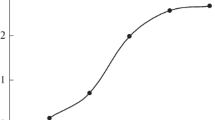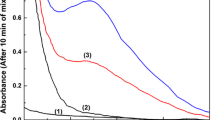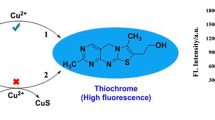Summary
The enhancement of the reducing power of the mercurous ion in presence of thiocyanate can be used for its detection. The most suitable method is to add an excess of thiocyanate and ferric salt, and to detect the ferrous ion formed with o-phenanthroline or dimethylglyoxime. With the former the sensitivity (pD) is 5.0 and the interferences are Cu2+, PtCl 2-6 , Co2+, Fe2+ and Sn2+. With the latter the sensitivity (pD) is 4.7, and the interferences are Cu2+, Co2+, Ni2+, Fe2+, Sn2+, PtCl 2-6 and VO -3 .
Similar reactions can be used for the detection of metallic mercury but many metals interfere.
Some other redox indicator system can also be used, but they are less applicable than the system indicated above.
Zusammenfassung
Die bei Gegenwart von Rhodanid erhöhte reduzierende Wirkung von Quecksilber-I-Ionen kann zu deren Nachweis verwendet werden. Am besten fügt man einen Überschuß von Rhodanid und Eisen-III-Salz zu und weist die gebildeten Eisen-II-Ionen mit o-Phenanthrolin oder Dimethyldioxim nach. Bei Anwendung des ersteren Reagens beträgt die EmpfindlichkeitpD = 5,0, wobei Cu++, PtCl --6 , Co++, Fe++ und Sn++ stören. Bei Anwendung von Dimethyldioxim beträgt die EmpfindlichkeitpD = 4,7, wobei Cu++, Co++, Ni++, Fe++, Sn++, PtCl --6 und VO -3 stören.
Ähnliche Reaktionen können zum Nachweis von metallischem Quecksilber dienen, werden aber von vielen Metallen gestört.
Einige andere Redox-Indikator-Systeme können gleichfalls herangezogen werden, sind aber weniger gut anwendbar.
Résumé
On peut utiliser l'exaltation du pouvoir réducteur de l'ion mercureux en présence de thiocyanate pour sa détection. La méthode la plus convenable consiste à ajouter un excès de thiocyanate et de sel ferrique et de détecter l'ion ferreux formé avec l'o-phénanthroline ou la diméthylglyoxime. Avec la première, la limite de sensibilité estpD = 5,0 et les interférences sont dues à Cu2+, PtCl 2-6 , Co2+, Fe2+ et Sn2+. Avec la dernière, la sensibilité estpD = 4,7 et les interférences sont dues à Cu2+, Co2+, Ni2+, Fe2+, Sn2+, PtCl 2-6 et VO -3 .
Des réactions similaires peuvent être employées pour la recherche du mercure métallique mais de nombreux métaux interfèrent. D'autres systèmes redox peuvent être aussi utilisés mais ils se montrent moins convenables que les précédents.
Similar content being viewed by others
Bibliography
F. R. Bradbury andE. C. Edwards, J. Soc. Chem. Ind.59, 96 T. (1940).
W. Pugh, J. Chem. Soc. London1945, 588.
H. Flaschka, Mikrochem.35, 473 (1950).
R. Belcher andT. S. West, Analyt. Chim. Acta5, 260, 268, 472 (1951).
Id., ibid.5, 364 (1951).
Id., ibid.5, 474 (1951).
Id., ibid.5, 360 (1951).
F. Burriel-Marti andF. Lucena-Conde, Anal. Fis. Quim., B47, 257 (1951).
Id., Analyt. Chim. Acta4, 344 (1950).
F. Burriel-Marti, F. Lucena-Conde andS. Bolle, unpublished work.
P. W. West andL. Conrad, Mikrochem.35, 443 (1950).
F. Feigl, Qualitative Analysis by Spot Tests, Elsevier Pub. Co. New York 1947. p. 125, 98.
F. Feigl andL. Miranda, Ind. Engng. Chem., Analyt. Ed.16, 141 (1944).
J. Gillis, Verhandel. Koninkl. Vlaamse Acad. Wetenschappen, Belg.6, n° 10, 11 (1944); Chem. Abstr.40, 4316 (1946).
Rapport de la Commission des réactifs nouveaux. Mikrochem.38, 601 (1951).
Author information
Authors and Affiliations
Rights and permissions
About this article
Cite this article
Lucena-Conde, F. A new test for the mercurous ion. Mikrochim Acta 40, 8–14 (1952). https://doi.org/10.1007/BF01413304
Received:
Issue Date:
DOI: https://doi.org/10.1007/BF01413304




